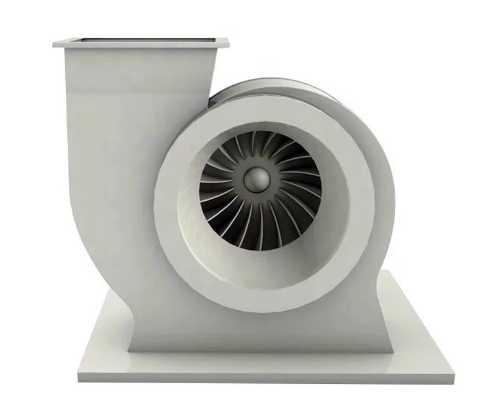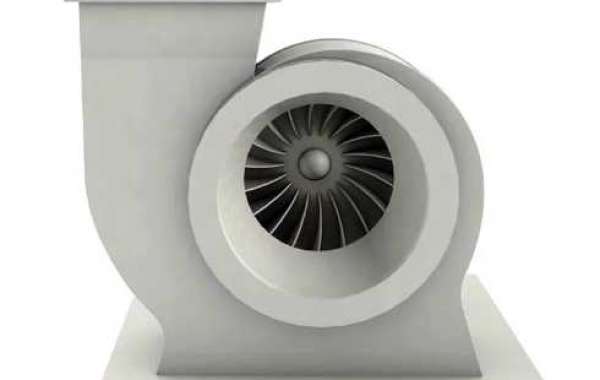PP centrifugal fans are industrial fans designed to move air or other gases in various industrial applications. PP stands for polypropylene, which is a type of plastic that is resistant to corrosion and can withstand high temperatures. These fans are commonly used in chemical processing plants, laboratories, and other facilities that require the movement of corrosive or high-temperature gases.
PP centrifugal fans work by drawing air or gas into the fan inlet and then accelerating it radially outward, using centrifugal force. The air or gas is then directed through a volute or other type of housing, which converts the kinetic energy of the air or gas into pressure. The pressurized air or gas is then discharged through the fan outlet.
PP centrifugal fans are typically used in applications where the air or gas being moved is corrosive, such as in chemical processing or in laboratories where hazardous substances are being used. They are also used in high-temperature applications, where the fan must be able to withstand the heat. PP centrifugal fans can be designed to operate in a range of temperatures and pressures, and can be customized to meet specific industrial requirements.
The fan Impellers are made of Polypropylene material. These materials have characteristics of rigidity, hardness, and toughness.
The fan impellers perform well in the tests of aging, vibration, and corrosion resistance. It is commonly used in mechanical parts like automobiles and ventilation fans. The cone design in the impeller can help reduce the problem of rust and disassembly.

Why Choose PP Centrifugal Fans?
There are several reasons why PP centrifugal fans are a popular choice in various industrial applications:
Corrosion resistance: PP is a plastic that is highly resistant to corrosion, making it an ideal material for use in fans that handle corrosive gases or liquids. This property ensures that the fans are long-lasting and require minimal maintenance.
High-temperature resistance: PP can withstand high temperatures, making it suitable for use in high-temperature applications. This makes PP centrifugal fans a preferred choice in industries such as chemical processing, where high temperatures are involved.
Chemical resistance: PP is resistant to a wide range of chemicals, making it suitable for use in industries that handle hazardous substances. This ensures that the fans can operate efficiently and safely in such environments.
Lightweight: PP is a lightweight material, making the fans easy to install and move around if required. This makes them a cost-effective option as they require less time and effort for installation and maintenance.
Customizable: PP centrifugal fans can be customized to meet specific industrial requirements, such as flow rate, pressure, and temperature range. This ensures that the fans are tailored to the needs of the specific application, leading to better performance and efficiency.
Overall, PP centrifugal fans offer a range of benefits that make them a reliable and cost-effective option for various industrial applications.
How to install PP Centrifugal Fans?
The installation process for PP centrifugal fans will vary depending on the specific fan model and the application it is being used for. However, here are some general steps that can be followed for installing PP centrifugal fans:
Determine the correct location: The fan should be located in a place that will allow it to operate efficiently and safely. The location should also be easily accessible for maintenance purposes.
Prepare the mounting surface: The surface where the fan will be mounted should be level and sturdy. If required, the surface should be reinforced to ensure it can support the weight of the fan.
Connect the ductwork: The ductwork should be connected to the inlet and outlet of the fan. It is important to ensure that the ductwork is properly sealed to prevent any leaks.
Install the fan: The fan should be carefully lifted into place and secured to the mounting surface. The bolts and nuts should be tightened to the manufacturer's recommended torque specifications.
Connect the power supply: The power supply should be connected to the fan motor, following the manufacturer's instructions. It is important to ensure that the electrical supply is compatible with the fan's voltage and frequency requirements.
Test the fan: Before starting the fan, it is important to check that all connections are secure and the fan is properly aligned. Once this has been done, the fan can be started and tested to ensure it is operating efficiently.
It is important to follow the manufacturer's instructions when installing PP centrifugal fans to ensure proper installation and avoid any safety hazards. If you are unsure about the installation process, it is recommended to seek the assistance of a qualified professional.
Difference Between FRP Centrifugal fans and PP centrifugal fans
FRP (Fiber Reinforced Plastic) and PP (Polypropylene) centrifugal fans are both used in various industrial applications to move air or other gases. However, there are some key differences between the two types of fans:
Material: The main difference between FRP and PP centrifugal fans is the material used to manufacture them. PP fans are made from polypropylene, which is a type of plastic. FRP fans, on the other hand, are made from a composite material that consists of a polymer matrix reinforced with fibers.
Corrosion resistance: Both PP and FRP fans are resistant to corrosion. However, FRP fans are generally more resistant to corrosion than PP fans. This makes FRP fans a preferred choice in applications where the fan will be exposed to harsh or corrosive environments.
Temperature resistance: PP fans can withstand high temperatures, but FRP fans are generally better suited for high-temperature applications. FRP fans can withstand temperatures up to 200°C, whereas PP fans typically have a lower maximum temperature rating.
Strength and durability: FRP fans are generally stronger and more durable than PP fans. The fibers used to reinforce the polymer matrix in FRP fans give them increased strength and stiffness, making them less likely to deform or break under stress.
Cost: FRP centrifugal fans are generally more expensive than PP fans due to the more complex manufacturing process and the higher cost of materials.
Overall, the choice between FRP and PP centrifugal fans will depend on the specific requirements of the application. If the fan will be exposed to harsh or corrosive environments, FRP fans may be the better choice. If high temperatures are not a concern and cost is a consideration, PP fans may be the better option.








